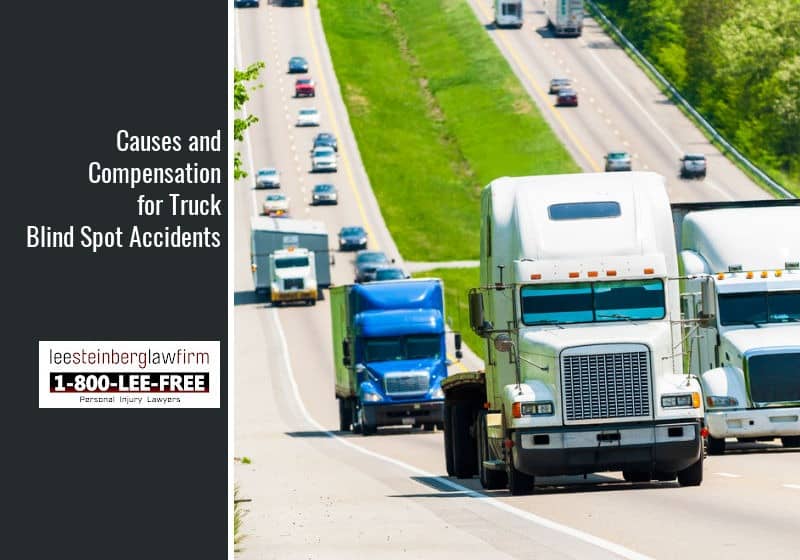
Semi-trucks on their own can weigh thousands of pounds, and with freight loaded, they can weigh up to 80,000 pounds. So, when truck drivers get into accidents, like truck blind spot accidents, you can imagine the damage they can cause, especially if the cargo being transported is also inherently dangerous, such as large machinery or even toxic chemicals.
This is why truck drivers and trucking companies have strict regulations they must follow and why they must be more careful when operating these large commercial vehicles. However, one of the biggest problems when it comes to semi-trucks is blind spots.
Even if a truck driver follows all road regulations and rules, a blind spot accident can still happen. Unfortunately, Michigan semi-truck blind spot accidents can be tragic, especially when they involve much smaller passenger vehicles. As such, it’s crucial that other drivers on the road understand how these blind spots work so they can be more mindful and help prevent these accidents from happening.
If you have been in a truck blind spot accident, our Michigan semi-truck accident attorneys at the Lee Steinberg Law Firm can help while you focus on your recovery. Our personal injury lawyers understand the intricacies of semi-truck accidents and can help you get the compensation you deserve.
What Is a Blind Spot?
Blind spots are areas you can’t see when looking in your mirrors. Even if a truck driver is being careful, accidents can still happen due to the extra-large blind spots they have compared to other vehicles. While a semi-truck blind spot mirror—which is just a larger side mirror—does help the driver get a larger view of the road around their truck, there are still blind spots that they can’t see.
What Is a Truck’s Blind Spot Called?
Trucks have large blind spots called “No Zones” by the Federal Motor Carrier Safety Administration (FMCSA). In other words, they are zones that other drivers should avoid as the truck driver will not see them, and, thus, driving in one of these blind spot zones could lead to an accident.
There are a total of four “No Zones” listed by the FMCSA:
- Directly behind the truck up to 30 feet
- Directly in front of the truck up to 20 feet
- In the lane directly to the left of the truck for about ¾ the length of the truck
- Two lanes to the right of the truck up to about 10 feet
You should always avoid driving directly next to the truck, directly in front of the truck, and directly behind the truck. The illustration provided in the link above can give you a clearer picture of where it is and is not safe to drive. A passenger vehicle’s blind spots are much smaller, approximately 9 feet behind the vehicle, but caution should taken when driving to avoid any type of blind spot accident.
How to Reduce the Risk of Semi-Truck Blind Spot Accidents
While the truck driver themselves must take extra precautions to check their blind spots, other drivers must also be aware of these blind spots and avoid them if possible. The FMCSA offers the following tips for driving safely around large trucks to avoid semi-truck accidents:
- Stay out of the “No Zones” if possible.
- When you need to pass a truck, make sure you use your turn signal and give the truck driver time to notice you, then pass them as quickly as possible. Do not linger next to them in their blind spot.
- Avoid merging directly next to or in front of a truck, as you will likely be in their blind spot and will not be seen.
- Do not tailgate large trucks, as they have a 30-foot blind spot directly behind the trailer.
- Trucks must make wide turns and can often not see cars directly next to them to the right when they do so. So anticipate when they are going to turn and give them space.
The FMCSA also notes that drivers should generally be more patient with truck drivers to avoid accidents. Understandably, getting stuck behind a slow-moving truck can be frustrating, but truck drivers drive more slowly and cautiously on purpose to adhere to federal regulations and Michigan truck laws. Honking your horn at truck drivers, driving around them aggressively, and cutting them off will just make the situation worse and can lead to an accident.
Compensation for Semi Truck Blind Spot Accidents
Every semi-truck accident is unique, so there is not an average amount listed for compensation that may be available. Factors that may be considered when determining a settlement may include:
- Percentage of fault for all parties involved in the accident.
- Seriousness of any injuries sustained.
- How the victim’s life has been affected
- Emotional and psychological trauma that resulted from the accident.
- Permanent injuries or disfigurement
- Medical expenses
- Loss of current or future income
- Insurance policy limits
Our Michigan Semi Truck Accident Lawyers Are Here to Help
At Lee Steinberg Law Firm, our semi-truck accident attorneys understand the physical and emotional damages that can impact your life after a blind spot accident. Not only are these types of accidents traumatizing, but the claims process can be difficult to navigate as well. For over 40 years, our team has worked tirelessly to help truck accident victims receive the compensation they deserve.
If you or a loved one has been in a semi-truck blind spot accident, contact us on our website or call us today at 1-800-LEE-FREE for a free consultation.

